Monumental Church
Introduction
Text-to-speech Audio
Images
Octagonal design of Monumental Church
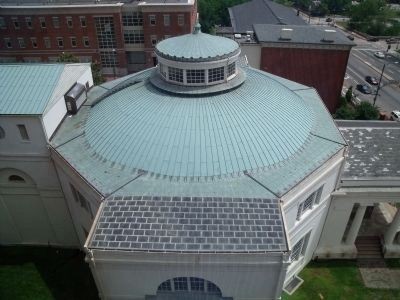
Monumental Church was built to commemorate the 72 victims of the Richmond Theatre fire. Photo taken circa 1865.
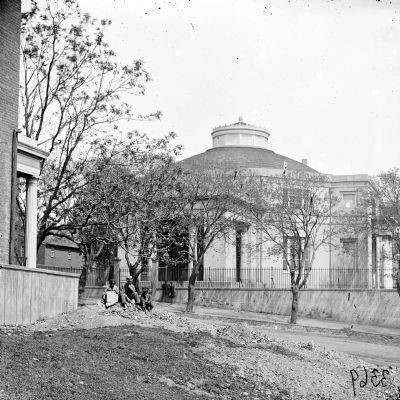
Interior of the church. The pew with the caption "Allan Pew" is the pew Edgar Allan Poe sat in when he was a parishioner of the church.
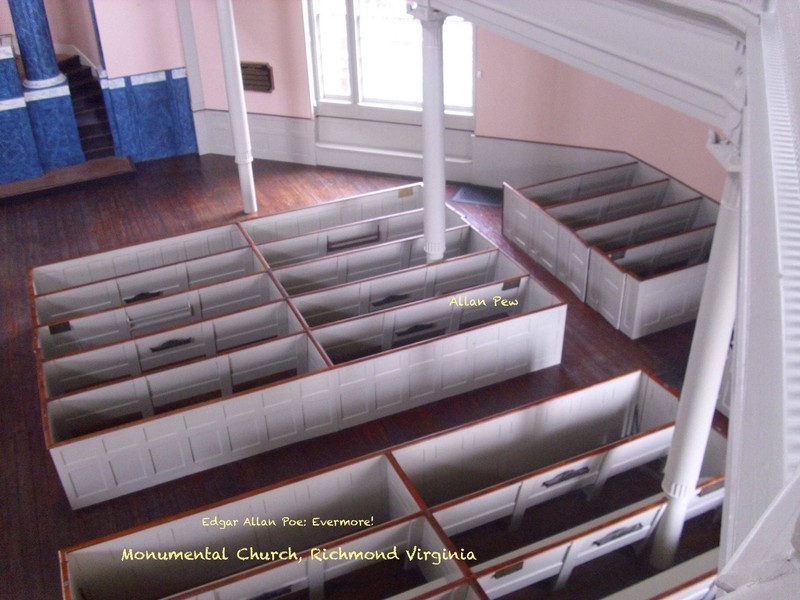
Early-mid 20th century photo of the church.
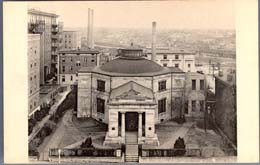
Robert Mills concept for the church's interior (1812). Courtesy of the University of Vermont (UVM)
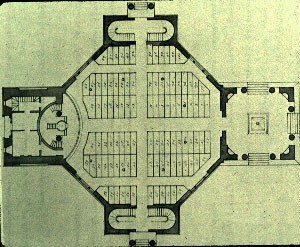
undated rendition of the 1811 Richmond fire. Building in center was the Richmond Theatre
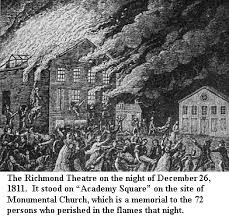
This crypt underneath the church contains the ashes the the fire's 72 victims
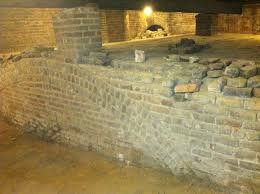
This circa 1831-35 china dessert plate from the J & J Jackson family (and sold at an auction in 2011) contains an image of the Monumental Church.
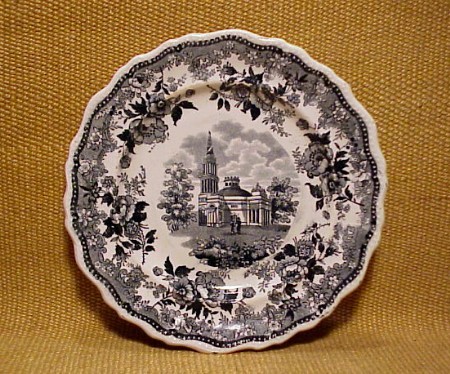
Backstory and Context
Text-to-speech Audio
Richmond’s famous Monumental Church came into existence out of tragedy. The site on which the church presently sits was once where the Richmond Theatre stood, a wood framed theatre building. The night of December 26, 1811 saw the Richmond Theatre welcome a full house to an evening performance. During the second act, however, stage scenery caught fire. The flames soon engulfed the wooden building and led to the death of 72 attendees, which included Virginia Governor George William Smith and his wife. The death toll would have been higher were it not for the rescue effort by Gilbert Hunt, an enslaved Blacksmith. The fire at the Richmond Theatre was so voracious that only ashes were left of those who perished inside the building.
Richmond’s civic leaders decided to honor the deceased by erecting both a monument and a church at the location of the former theater. Supreme Court Justice John Marshall headed the committee that raised public funds for the project and commissioned the architectural design. In 1812, the committee chose a design put forth by Roger Mills. Mills, once a student of Thomas Jefferson and draftsman for Benjamin Henry Latrobe at the time, is considered by many as the first American-born professional architect. Mills’ design combined both monument and church within a single structure, being one of the country’s earliest and most distinct examples of Greek Revival architecture. Serving two purposes as a church and a memorial, the Monumental Church possesses distinct sections for each purpose: the gable front portico, with its square, memorial-like design, covers the monument honoring those lost in the fire; and the domed, octagonal center serves as the church. The octagonal body of Monumental Church is decorated with classical motifs as well as with funerary imagery. The capitals of the columns that stand on both sides of the pulpit feature upside-down torches – symbolizing the end of life, stars—symbolizing heaven, and drapery—symbolizing a burial shroud. Mills’ redesign of the church sanctuary, by shifting the congregation’s primary focus to the pulpit, initiated a new wave of religious architecture. The remains of those who perished in the fire are buried in a brick crypt below the sanctuary. When completed in 1814, the Monumental Church became the one of the most unique architectural designs in not only Virginia but in the United States. The church is now the only remaining among the four domed churches that Mills designed in the country.
Most individuals who donated to the construction of the Monumental Church became members of the newly erected Episcopal church. Notable members were Supreme Court Justice John Marshall, John Wickham, and John and Frances Allan, foster parents of Edgar Allan Poe. The Allans donated $230 and subsequently owned pew #80. Poe spent his childhood Sundays in this pew, listening to biblical scriptures and sermons. Interestingly enough, Poe’s actress mother, Eliza Poe, gave her last performance in the Richmond Theatre in December 1811, two weeks before the theatre burned.
The Monumental Church survived the Civil War and continued to serve an active congregation until its de-consecration in 1965. At that point, the church was donated to the Medical College of Virginia and used as the school’s interfaith chapel. In 1983, Historic Richmond purchased the church and has worked to restore and rehabilitate the building and surrounding property. The Monumental Church is available for weddings and by appointment.
The Monumental Church was designated a Virginia Landmark on November 5, 1968, added to the National Register of Historic Places on April 16, 1968, and designated a National Historic Landmark on November 11, 1971.
Sources
Monumental Church, 1224 E. Broad Street. Historic Richmond. May 19, 2019. https://www.historicrichmond.com/property/monumental-church/.
Monumental Church. National Park Service. May 4, 2019. https://www.nps.gov/nr/travel/richmond/MonumentalChurch.htm.
Accordino, Mario. Monumental Church. Architecture Richmond. October 17, 2012. May 4, 2019. http://architecturerichmond.com/inventory/monumental-church/.
Monumental Church. The Cultural Landscape Foundation. May 4, 2019. https://tclf.org/landscapes/monumental-church.
Loth, Calder. Monumental Church Classical Comments by Calder Loth. Institute of Classical Architecture and Art. October 23, 2012. May 4, 2019. https://www.classicist.org/articles/classical-comments-monumental-church/.
127-0012 Monumental Church. Virginia Department. March 22, 2019. May 4, 2019. https://www.dhr.virginia.gov/historic-registers/127-0012/.
Virginia Historic Landmarks Commission. National Register of Historic Places Inventory - Nomination Form. Virginia Department of Historic Resources. April 16, 1969. May 4, 2019. https://www.dhr.virginia.gov/VLR_to_transfer/PDFNoms/127-0012_Monumental_Church_1969_Final_Nomination_NHL.pdf.
